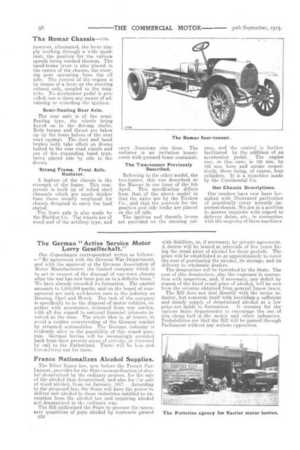Romar Commercial Vehicles.
Page 17

Page 18

If you've noticed an error in this article please click here to report it so we can fix it.
A Comprehensive Range of Worm-driven Chassis. Two Tons to Five Tons Net Load Accommodation.
A new and fairly complete range of assembled American chassis is now, available from Romar Lorries, Ltd., Brook Mews North, Paddington. We say " mew" advisedly, because, although we are aware that a number of these has been sold, some of which are operating with success, we are told, in the hilly districts of Lancashire and on the villainous roads for which some portions of that county are noted, it is, nevertheless, impossible to point to any records compiled during lengthy service in this country in proof of the claim that they are the equal of the best British-made article. In respect of the lack of such evidence, they differ in no way from the great majority of imported chassis. This is disability which is unavoidable in the circumstances, as until the British market assumed its recent remarkable characteristics few American commercial models had been offered here.
Built of Well-known Units.
The load capacities of the variou.s machines vary from two tons to five tons net. The specifications vary somewhat, and we must, therefore, to some extent, confine, ourselves to the four-tonner, to which we paid particular attention, together with a brief reference to the two-tonner which we also saw on the occasion of our visit. On the larger of these two models the specification includes a Wisconsin engine of ample size arid or a type used on other U.S.A. models, built. in one unit with a Brown-Lipe gearbox and multidisc clutch, the whole being threepoint suspended. Thence the power is transmitted by means of a cardan shaft to a bearing midway along. the frame, the final transmission being by a second uni
versally jointed shaft to an overtype worm-driven Sheldon rear axle. We have dealt in some detail at various times with each of these units as fitted to other chassis.
The Engine.
The Wisconsin engine is a fourcylinder, water-cooled unit, with cylinders cast in pairs. The design necessitates the use of two camshafts, the induction and exhaust valves being on opposite sides of the engine. Each valve and spring are enclosed by a special type cast aluminium cover in halves, held together, and in position, by a spring clip. The centrifugal type water pump is on the near side of the engine. The carburetter, which draws air from an exhaust-heated muffle, is situated on the off side, as also is the high-tension magneto which is provided for the purpose of ignition. We were Fortunate in being able to examine one of these engines which was partly dismantled, and were able in consequence to observe the robust nature of some oF its internal components. The connecting rods, in particular, struck us as being well up to their work, the big-ends being held by four bolts. The gudgeon pins also were of ample size. Lubrication is by means of a pump which forces oil through the main bearings as well as to the bushes in the timing case for the shafts driving the water pump and magneto. The remainder of the bearings, including the big-ends, are fed by splash. An easily-visible. oil-depth indicator is provided on the top of the crankcase ; this is always a useful fitting.
Three-spud Gearbox. Central Control.
The gearbox, as we have stated, provides three speeds forward and one reverse. The controlling lever is placed in the centre of the chassis and operates on the gate principle ; the more usual slots are,
however, eliminated, the lever simply working through a wide quadrant, the position for the 'varioui3 speeds being marked thereon. The hand-brake lever is also placed in the centre of the chassis, the steering gear operating from the oft side. The control of the engine is by means of a lever on the steering column only, ,coupled to the magneto. No accelerator pedal is provided, nor is there any means of advancing or retarding the ignition.
Semi-floating Rear Axle.
The rear axle is of the semifloating type, the wheels being keyed on to the driving shafts. Both torque and thrust are taken up by the front halves of the rear roaft ;springs. The ifoot and hand brakes both take effect on drums bolted to the rear road wheels and are of the expanding band type, beieg placed side by side in the drums.
Strong Frame. Front Axle. Radiator.
A feature of the chassis is the strength of the frame. This component is built up of rolled steel_ channels which are much thicker than those usually employed for chassis designed to carry the load stated.
The front axle is also made by the Sheldon Co. The wheels are of wood and of the artillery type, and carry American size tires. The radiator is an imitation honeycomb with pressed brass container.
The Two-toaster Previously Described.
Referring to the other model, the two-tonner, this was described as the Itgaccar in our issue of the 8th April. This specification differs from that of the above model in that the axles are by the Timken Co., and that the controls for the gearbox and side brake are placed on the off side.
The ignition and throttle levers are provided on the steering col umn, and the control is further facilitated by the addition of an accelerator pedal. The engine size, in this -.case, is 105 mm. by 135 mm. bore and stroke respectively, there being, of course, four cylinders. It is a monobloc made by the Continental Co.
Our Chassis Descriptions.
Our readers have now been furnished with illustrated particulars of practically every recently .imported chassis. We are in a position to answer inquiries with regard to delivery dates, .etc., in connection with the majorityof those machines.






















